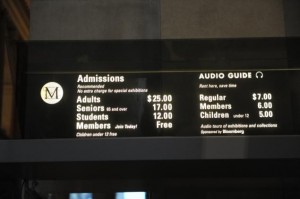New York’s Metropolitan Museum of Art is being sued for strongly suggesting that its “recommended” donation for entry is in fact required of visitors. Associated Press reports:
‘The museum was designed to be open to everyone, without regard to their financial circumstances,’ said Arnold Weiss, one of two attorneys who filed the lawsuit on behalf of three museum-goers, a New Yorker and two tourists from the Czech Republic. ‘But instead, the museum has been converted into an elite tourist attraction.’
In the New York Daily News, James Panero writes:
And the Met’s suggested admissions fee has skyrocketed, further shaming museum-goers into paying higher amounts. Since 1992, the Met’s recommended adult entry fee has increased 150% adjusted for inflation, from $6 (which is roughly $10 in today’s dollars) to $25.
I will leave the question of “recommended” and “suggested” fees for another post. Here, I just want to consider the amount itself, which has “skyrocketed” to $25.
This is not a high price. Put aside how much it has increased over the past twenty years, since old prices are not what is relevant here. Instead, think of the current price as it stands. Admission is $25 for adults, $17 for seniors, $12 for students, and children under 12 are free. I can take my three children to see one of the greatest collections of visual art in the world for about the same family price as taking them to see The Croods this weekend. It would cost me less than a family lunch at our local Applebee’s.
 If I only consider the single adult admission, I can spend a full day with this collection for far less than the price of any show on Broadway, and most shows off-Broadway. It’s roughly the cost of two movies, or two hardcover books (if they are on sale) or three paperbacks (ditto). It’s less than the cost of the vast majority of seats for any professional sports team – all $25 will get you at Citi Field is a chance to see the Mets from the outfield at nosebleed heights, any other seat will cost you more. $25 will not get me to an ordinary concert with the New York Philharmonic. It can get me into the highest balcony for the Metropolitan Opera, but no closer. But $25 (the top price) will get me a full day up close with an astounding collection of art.
If I only consider the single adult admission, I can spend a full day with this collection for far less than the price of any show on Broadway, and most shows off-Broadway. It’s roughly the cost of two movies, or two hardcover books (if they are on sale) or three paperbacks (ditto). It’s less than the cost of the vast majority of seats for any professional sports team – all $25 will get you at Citi Field is a chance to see the Mets from the outfield at nosebleed heights, any other seat will cost you more. $25 will not get me to an ordinary concert with the New York Philharmonic. It can get me into the highest balcony for the Metropolitan Opera, but no closer. But $25 (the top price) will get me a full day up close with an astounding collection of art.
Furthermore, it is evident that people are willing to pay this price. The Met is not wanting for visitors.
I do not know how it came to pass that museums should be charging less for what they give to their patrons than other art forms. Asking for $25 requires no apology.


I actually agree with you completely that the entrance fee to the Met is not, relatively, high at all. But there are some ancillary issues that affect how we view this. For one thing, in the past it was generally true that entry to most museums was free. (I’m pretty sure that when I started to go to the Met, it was free. On the other hand, I have a dim recollection of going to MOMA around that time and paying something to enter.) But the recollection that museums were once free, and the knowledge that the Met is supposed to be free, do play into our attitudes about how much it now costs. Second, the Met gets a lot of support from the city already, so taxpayers (if not visitors from elsewhere) are already paying a certain amount for the Met. Third, the Met is an educational museum; the entry fee (even a small one) automatically screens out the very people who might wander in for free and have a life-changing experience. Fourth, the Met holds art in trust for the public; in at least some sense, the art already belongs to the public. (I know that actual ownership is a knotty question.) Plus, the Met is not the only game in town. I believe that every single NY museum has an entry fee, and those entry fees–even for just one individual–add up. I agree that the cost, relative to other costs is not high, but going to a museum (where art is held in trust for the public) is different from paying for a movie ticket or a sporting event. Just for the record, I am a member of about 5 or 6 museums in NYC; it’s my passion. I love museums; I want everyone to go as often as possible.
You make an interesting point but I think you miss the bigger picture: the high admission fees charged by museums don’t reflect the high value that we, as a society, place on art; they cheapen it. Libraries are free because we consider access to books and other information essential to meaningful citizenship in our society. If the Met were to raise it entrance fees (suggested, recommended or otherwise) to $50, it would show that we just don’t give a damn about art altogether.
It depends on whether the organization can function at a decent level (i.e. quality of its offerings and salaries paid to artists and staff) on those revenues.
Frankly, I would rather pay MORE instead of having ticket prices axed and musician salaries slashed because the talking point is “we don’t have a revenue problem, we have an expense problem”. And I do feel that, in some cases, lowered prices lead to devaluation of the “product” in the minds of the purchasers.
As for libraries – well, I work in one, and libraries are NOT free – they require significant amounts of (usually local) tax dollars. Given the slashed budgets during the last 5 years, it’s pretty obvious that “we” do not always “consider access . . . essential to meaningful citizenship in our society”. Would that we did. Demand is up, and materials and staff dollars are down. No wonder I’m exhausted at the end of each day.
My point is that cutting tax subsidies for institutions while increasing access fees does, indeed, devalue these institutions. And the argument put forward by the author that high admission fees paid by patrons is money well spent compared to, say, a baseball game at Citi field is beside the point. We fund (through subsidies) things that we value, and we don’t subsidize things like baseball games, which are mere entertainment. If the Met is raising access fees because government subsidies are being cut, I think that’s sad. It tells me that we don’t care if poor (and not so poor) people can’t afford to visit the Met. Frankly, I don’t give a damn if they can afford to go to a Mets game.
The lack of empathy and narrow upper middle class mindset behind this essay reminds me of the response I got from an older Manhattan alumna when as a recent Smith graduate I expressed concern over the $20 price of a NY club event. I remember vividly how I felt when she dimissed the cost as “Nothing more than cab fare”–in fact, I, on my Columbia University graduate student budget had to think carefully about even taking the bus.
However, you have to take into consideration that museums are worth paying admission fees. When a museum drops its admission fee the quality of the museum goes down. Numerous examples, such as the Smithsonian Institute in 2012 when they dropped their admission fee also lost 7% of their annual visitors. Art and culture are valuable enough to be paid for. Another point is that allowing free admission is not the best use of museums resources. Many museums that do not charge admission have had to be closed due to not having enough funds. In the end the old economic law of TANSTAAFL – there ain’t no such thing as a free lunch – still applies today.
Clearly the author of this article doesn’t believe everyone should have access to art. It’s going to be really hard for museums to shake their stuffy, exclusive reputations when they fail to consider those in lower income brackets as valuable patrons.
Yes, one does wonder how the mission of broadening audience demographics fits with a suggested admission of $25. How many first-time museum-goers have arrived and been too shy NOT to fork over $25 (per person!) that they could ill afford–never to return? It is wrong to humiliate people of lower economic status in this way. Especially given the amount of energy dedicated to dispelling any aura of elitism at museums.
If the Met is serious about welcoming lower-income visitors, the signs should read, “PAY WHAT YOU WISH–the Museum gratefully suggests an admission contribution of $25 for those who can afford it.” Admissions constitute only a small portion of the museum’s overall annual income anyway.
Another point is that one visits museums regularly–one usually does not see the same movie for $15 more than once. You go to visit the permanent collection of a museum, again and again. Museums are like secular places of worship–if you have to pay $25 or more every time you visit, you will go broke. The charge for ticket prices for new exhibits makes sense, but entry to permanent collection should not prohibit regular visits or it defeats the value of art in our lives and world.
In Edwin G. Burrows’ and Mike Wallace’s massive “Gotham”, a history of NYC through 1898, the authors describe how the founders of the Met initially wanted to restrict hours to weekdays only, explicitly to keep out the working class. Fortunately they did not prevail.
Now it seems that the trustees have that same goal in mind today.